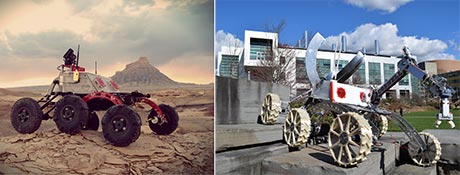Student Mars Rover team will compete in Utah desert
By Bill Steele


A team of Cornell engineering students has advanced to the finals of the University Rover Challenge, a competition to build and operate a prototype radio-controlled vehicle that could assist astronauts exploring Mars. They will travel to a test site in the Utah desert May 28-30 to match their rover against those deployed by 22 other teams.
The Mars Society, founded 16 years ago to promote human exploration of Mars, sponsors the competition. It has created a simulated Mars base near Hanksville, Utah, where rovers will be challenged to travel over uneven terrain of sand and rocks, performing tasks that might assist Mars colonists, such as picking up and analyzing soil samples, delivering tools to work sites or servicing equipment.
The winning team will receive a cash prize, a year’s worth of bragging rights and a trip to present their design at the International Mars Society Convention Aug. 13-16 in Washington, D.C. A record 44 teams entered this year, and after a design review 23 were selected to continue.
The Cornell Mars Rover team, created in 2010, has entered four annual competitions. This year’s rover will incorporate several innovations over previous models, according to team leader Marhitha Rachumalla ’15. Rubber tires have been replaced by 3-D printed plastic wheels with a ribbed surface for better traction in sand, mounted on spring-loaded arms that adjust to uneven ground. The robot arm has been upgraded to handle a 10-pound load with improved grippers, and the radio control was redesigned.
“A problem [in previous years] was that we didn’t focus enough on testing,” Rachumalla said. “We have formed separate subteams just for testing.” The rover has been driven around the arts and engineering quads, and to test the radio control system the team drove it up Tower Road from Malott Hall to the Dairy Bar, working from a control center in Morrill Hall. The system is designed to work up to several kilometers from home base, out of site of the controllers, and must have enough bandwidth to transmit commands and send back video.
The team has more than 40 members working in subteams for drive systems, task systems, controls, software and business. Capt. Kevin O’Brien, USAF, visiting lecturer in aerospace studies, is faculty adviser. O’Brien is a developmental engineer in the Air Force with experience in technical project management of Department of Defense contracts.
The business team, which includes students outside the College of Engineering, has secured sponsorships from Anoplate, Boeing, DipTrace, Go Pro, Midwest Motion Products, MOOG, SolidWorks, Stratasys and TE Connectivity. Some sponsors contribute equipment and expertise rather than money. There is also a crowdfunding campaigncrowdfunding campaign to raise additional support from the Cornell community.
Most team members are interested in space travel, said Justin Cray ’18, a freshman on the electrical controls subteam, and many former members have gone on to jobs in the aerospace industry. “People say, ‘Why do this, you can’t go to Mars,’” Cray noted. “It’s a way to educate people and promote space exploration.”
The Mars team is one of 24 student project teams sponsored by the College of Engineering, which provides administrative assistance, seed money and work space. Several teams enter intercollegiate competitions, including those to build race cars or autonomous submarines and aircraft. Others conduct service projects such as building water purification systems and bridges in Latin America.
“It’s one of the hidden gems here at Cornell,” said Rebecca Macdonald, the Swanson Director of Engineering Student Project Teams. “It gives an area for these students to do prototyping, going from idea to design to construct and test. They learn team building, leadership and business application, and interact with industry.”
Project teams currently involve 1,100 students, 200 of whom are not engineers. The program is supported by a $5 million gift from John A. Swanson ’61, M.Eng. ’63, along with other alumni gifts and department funding.
Media Contact
Get Cornell news delivered right to your inbox.
Subscribe